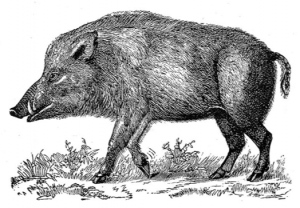
Sus scrofa
Native range: Eurasia
Invasive Range: Southeastern and Southwestern US, Midwest, California, Oregon, Hawaii. Spreading in the Northeast and Northwest.
Habitat: Found in a wide variety of habitats, from freshwater marshes to deserts. Common in forested areas with some openings.
Did the domestic ancestors of today’s feral pigs streak off De Soto’s ship into the Florida scrub of their own accord in 1539? Or did they have to be urged to go find something to eat? All you need to know about hogs to figure this out is that they’re omnivorous and smart.
In 1893, a robber baron imported 50 wild boars from the Black Forest and released them on a 20,000-acre private hunting preserve in New Hampshire. In 1910 and 1912, Russian wild boars were released on a North Carolina preserve. Animals from there were introduced in 1925 near Monterey, California, then a few years later on Santa Cruz Island. The last such introduction followed in Texas in 1930. Some transplants escaped from these preserves. They often bred with domesticated pigs; their offspring bred with feral pigs; the population soared. Free-ranging of swine was legal in the US until it was outlawed in the mid-twentieth century as part of a disease-eradication effort.
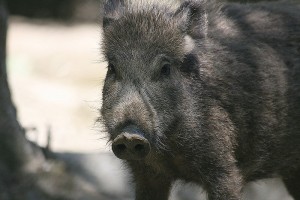
Wild boars breed three times a year, each litter yielding five to ten more of them. Since the creature has no natural predators, the survival rate of a litter is about 100 per cent. A pig population can double in four months. On top of that, illegal translocation of hogs by humans has contributed to their range extension.
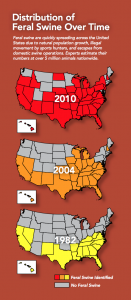 Today, feral pigs and pig-boar hybrids are found in at least 45 states, the largest populations in the coastal states surrounding the Gulf of Mexico and in California (not surprising, since Spanish explorers settled these). In locations where feral pigs have more recently been discovered, it is likely that these are escapees from domestic swine facilities, releases from game farms, or illegal stocking. “Ecological train wreck,” they’re being called in Texas by wildlife experts.
Today, feral pigs and pig-boar hybrids are found in at least 45 states, the largest populations in the coastal states surrounding the Gulf of Mexico and in California (not surprising, since Spanish explorers settled these). In locations where feral pigs have more recently been discovered, it is likely that these are escapees from domestic swine facilities, releases from game farms, or illegal stocking. “Ecological train wreck,” they’re being called in Texas by wildlife experts.
On beaches, wild pigs eat sea turtle eggs. In the desert, they root up plants that may not regrow for generations. They eat farmers’ crops; they cause soil erosion. They are linked to an outbreak of E. coli in California spinach that made 200 hundred sick and killed three. They are known to carry or transmit more than 30 diseases and 37 parasites, including swine brucellosis, which can be fatal to people, and pseudorabies, which can kill endangered Florida panthers. They can carry trichinosis, a parasitic disease caused by a roundworm that lodges in the host muscle.
When de Soto first arrived, these diseases may have ravaged Native American communities. In The Hernando de Soto Expedition, Ann Romenofsky and Patricia Galloway write that millions of Native people died because they lacked previous exposure to swine-borne diseases, such as brucellosis, leptospirosis, trichinosis, tuberculosis, cysticercosis, and several strains of flu.
These days, hog hunting has become popular in the South, though there is no evidence that wild pig populations are on the decline. Perhaps it is time to turn to the traditions of the Chianti region, where the boars are native. There hunters used dogs to chase the swine from the forest into open areas where hunters could shoot them at will. It was an efficient, if somewhat unsettling, way to kill wild hogs. (The practice is now banned in Italy.)
Wild boar has been called the ultimate organic pork, a gourmet meat. (Just don’t undercook it.) Texas chef Jon Bonnell notes, “It’s a leaner meat. And because they’re raised on a natural diet, they’re a little smaller, got less fat. It’s a little healthier, and the flavor is just rich as can be.”
Interested in trying some wild pig? Founding Foods has a new line of wild boar jerky that can be purchased here.
There are several purveyors of wild pigs in Texas. In the past few years, more than 450,000 pigs have been captured in the state, federally inspected, and sold in the U.S., Europe, and Asia. We have purchased some delicious hog meat from Broken Arrow Ranch.
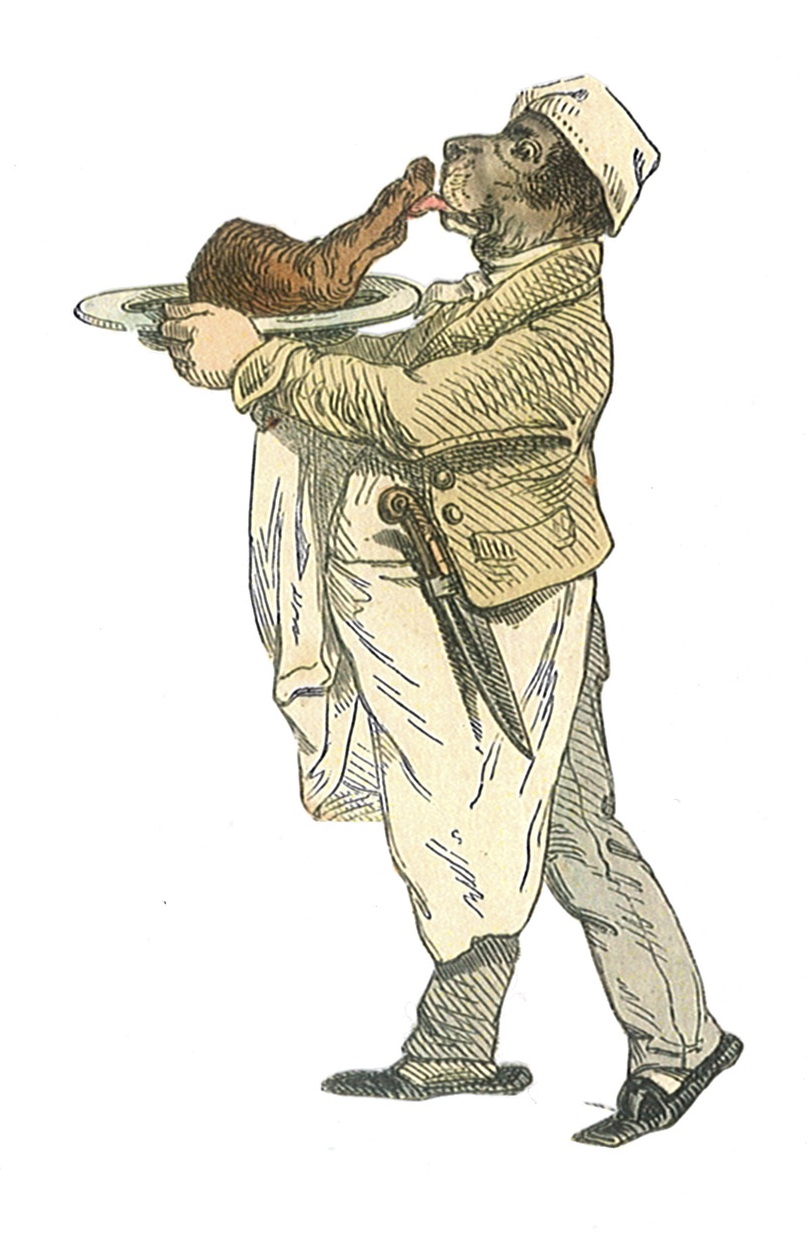
Sweet Wild Boar with Pickled Mustard Greens
Serves 8
This recipe was created by Eric Caravan at the University of Vermont for an Eat the Invaders! event at the university’s dining hall. It was a big hit with the students.
2 pounds wild pig shoulder
1 pound mustard greens
1/4 pound carrot
1/4 pound celery
1/4 pound onion
1 quart water
1 cup buttermilk
1 cup apple cider vinegar
1 cup apple cider
3/4 cup maple syrup
3/4 cup whole grain mustard
1/2 cup duck fat
2 tablespoons agave
1/4 cup brown sugar
1 tablespoon pickling spice
1/2 tablespoon salt
1/2 tablespoon pepper
Pickled Greens
1. Combine apple cider vinegar, brown sugar, and pickling spice in a pot and bring to a boil.
2. Place mustard greens in a sturdy heat-resistant container & pour pickling brine over the top.
3. Let mustard greens cool before covering and storing. Greens should sit for a minimum of 24 hours
Mustard
1. Combine 1/2 cup whole grain mustard, 1/4 cup maple syrup, and 2 tablespoons agave.
2. Serve aside boar.
Wild Pig
1. Marinade pork in buttermilk for 24 hours
2. Remove pork from buttermilk and rinse excess off.
3. Large dice carrot, celery, and onion and set aside in roasting pan.
4. Season pork with salt and pepper entirely.
5. Prepare a skillet with duck fat and sear all sides of pork until golden brown.
6. Place pork over carrots, celery, and onion in the roasting pan.
7. Rub 1/4 cup of mustard over pork.
8. Combine water, apple cider, and maple syrup, and pour around pork.
9. Cover pork and roast at 275 degrees for 2 hours or until fork tender.
10. Strain all liquid left in roasting into a pot and reduce until thick for a glaze.
11. Start pulling pork apart.
12. Add glaze to pulled pork and mix well.
Wild Boar Tenderloin with Asparagus Sauce
Adapted from Hank Shaw, Hunter, Angler, Gardner, Cook (honest-food.net)
This recipe combines springtime veggies and a perfect meat for spring — wild boar tenderloin. The only hard part is making the sauce, and that isn’t so much difficult as it is time-consuming. And the sauce can be made up to a day ahead. After that, this dish comes together very quickly, so if you have this sauce ready, you can even do this recipe on a weeknight.
A word on the medium-cooked wild pig. The boar Shaw used had been frozen for some time, which will kill any trichinae parasites should they be present (this is a remote possibility, but better safe than sorry). Should you have fresh pork, be sure to cook it to at least 140 degrees, which will kill the parasite; Shaw cooks his to about 145-150 degrees, which is a blush of pink.
Serves 2
1 pound wild pig tenderloin
2 tablespoons unsalted butter, divided
Kosher salt
1 pound asparagus
1 tablespoon olive oil
6 green garlic stalks
3 green onion stalks
1. Make the sauce. Get a large pot of water to a boil, and salt it well. it should taste like the sea. Blanch the green garlics and onions, white part down — hold them by the greens in the boiling water for 3-4 minutes. I suppose you could chop them in half and then blanch the two parts separately, but I have not tried this. After the white ends have been in for 3-4 minutes, toss the rest in and let it all boil for 2 minutes.
2. Remove and dump into a large bowl of ice water to cool. Take the veggies out and chop roughly. Put the green onions and green garlics into a food processor and buss the hell out of them, scraping down the sides from time to time. It will take a bit of doing to incorporate, but you will eventually get a bright green puree.
3. Now the hard part. Push the puree through a tamis or fine-meshed sieve. This will take some effort. Take your time and keep at it for about 10 minutes or so, or until there are only fibers in the mesh. Save the strained puree for now.
4. Salt the pork pieces well and set aside.
5. Turn on the broiler.
6. Using the tablespoon of olive oil, coat the asparagus well and then salt them.
7. Put one tablespoon of butter in a saute pan set on high heat. When the butter melts, turn the heat down to medium-high.
8. Put the asparagus under the broiler.
9. Saute the tenderloin over medium-high heat, turning to hit all sides. You are looking for medium here — just a blush of pink. When the tenderloins are about done, remove the asparagus (the timing should work out.)
10. Pour the green onion/garlic puree into a small pot and add the other tablespoon of butter, set of medium-low heat and swirl to combine. Do not let this boil. Add salt to taste.
11. Let the boar rest while the sauce heats up. The second the sauce begins to bubble, turn off the heat and lay down some sauce on the plate. Top with the asparagus, and then with the tenderloin cut thinly.
Wild Boar Carnitas with Jicama-Mango Salsa
The delicious-looking tacos at the top of the page are from Chowhound’s Game Meat Recipes for the Big Game.



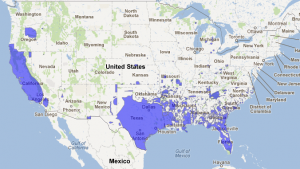
























{ 4 comments… read them below or add one }
Apparently no one except hunters, farmers and live stock ranchers
saw this coming. Invasive species
eradication might make a difference.
In Kansas it is both illegal to release or sport hunt feral pigs. The most common rationale is that, if legal, importing and sport shooting of these animals would increase the problem. Persons wishing to shoot these must either own the land where they hunt or obtain a written agreement involving the State Dept. of Agriculture. Just like controlling insects or communicable diseases, there is no permanent solution. Methods to control these pests might include: (1) allow night hunting of swine by certified shooters with night vision scopes, (2) high fines for those who import these creatures, (3) controlled daytime “pig drives” and (4) some type of state sanctioned bounty for each animal turned in–allowing biologists to monitor for diseases. Some enterprising Texans have advertised “free hunting opportunities for wild boar hunting.” The catch is that the “hosts” require that participants use their guides and costly meat processing services. The choice remains to either intensively control these beasts year around, or allow them to destroy crops, infect farm animals, and expand their ranges.
Be careful they carry 17 nasty diseases use gloves to butcher and cook very well. I had trivialized as a kid not pleasant and all you can do is to use meds to cause worms to form cyst never get rid o.f them
They have natural predators. Piglets can be taken by large birds of prey, coyotes, alligators, brown bears, the burmese python and mountain lions.
There are limited areas where wild hogs would meet such creatures but they exist. Some of these creatures will take on a large hog but most will not.